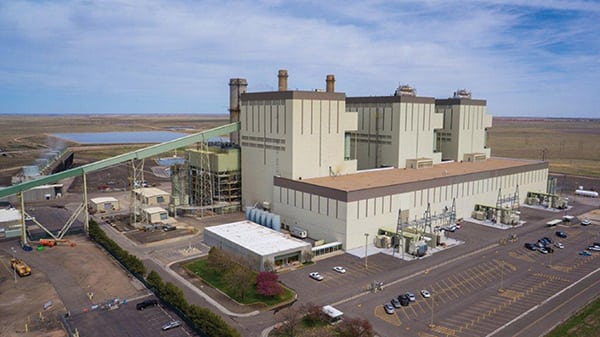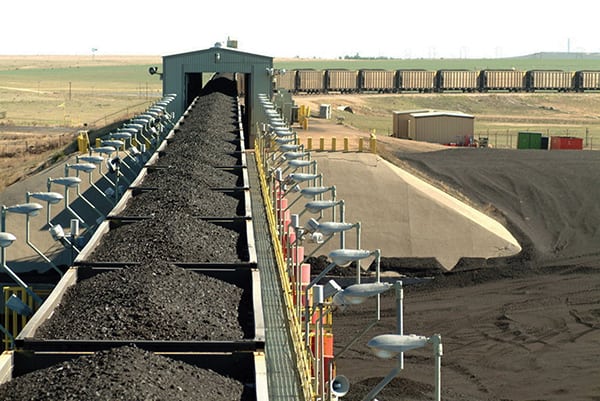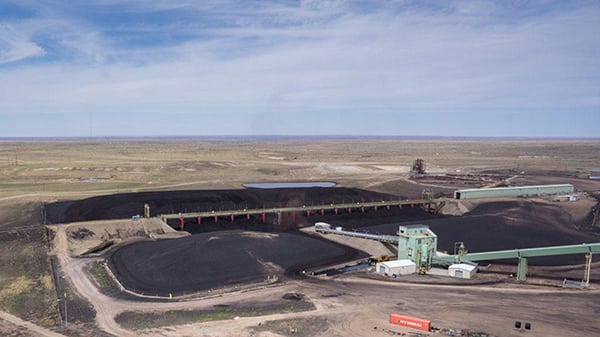Harrington Generating Station, located near Amarillo, Texas, began burning Powder River Basin (PRB) coal when its units first entered service, beginning in 1976. A unique feature of the plant is that TUCO Inc. buys and delivers the coal and Savage Services owns and operates the plant’s coal-handling facility. Incomparable housekeeping and exceptional safety performance evidence the success of the plant’s unique organization, which was recently recognized with the PRB Coal Users’ Group 2015 Plant of the Year Award.
Amarillo, located in the Texas Panhandle, is a city of many names. Some call it “The Yellow Rose of Texas” because the city’s name is taken from the Spanish word for yellow. Others call it “Rotor City, USA” because the V-22 Osprey military aircraft is assembled there. Still others have nicknamed Amarillo “Bomb City” because the country’s only nuclear weapons assembly and disassembly plant is located there. Xcel Energy’s Harrington Generating Station (HGS), located in the northeast edge of the city, brings to Amarillo added notoriety with the announcement that it received the Powder River Basin Coal Users’ Group (PRBCUG) 2015 Plant of the Year (PoY) award. Justification for the award is encapsulated by a comment made by one member of the PRBCUG site inspection team: “The plant is a seamless operation with a safety culture built upon the philosophy that everyone goes home a better person—every day.”
This is the 15th consecutive year that the PRBCUG has honored plants that burn PRB coal and demonstrate, according to its charter, “innovation and implementation of best practices and continual improvements in areas including safety, environmental performance, coal handling, boiler combustion, and risk management.” The group’s mission is achieved through educational opportunities, identifying and capturing industry best practices, and facilitating a network of users working together.
By taking PoY honors, HGS joins earlier winners in the PRBCUG’s Power Plant Hall of Fame. The trophy presentation and recognition ceremony took place on April 21, 2015, during the annual meeting of the PRBCUG, co-located with the 2015 ELECTRIC POWER Conference & Exhibition. Additional information about the group, its 2016 annual meeting, and the awards program is available at www.prbcoals.com and www.electricpowerexpo.com.
HGS consists of three 360-MW PRB-fired steam electric units built in 1976, 1978, and 1980 that were the first modern coal-fired plants built in the region. HGS was designed by the generation plant design group that was within Southwestern Public Service Co. (SPS, Xcel Energy’s Texas-based operating company). Each unit has a Combustion Engineering (now Alstom Power) tangentially fired boiler with five 863RS mills and a Westinghouse cross-compound steam turbine.
The plant does not have a flue gas desulfurization system or selective catalytic reduction, although activated carbon injection is used to reduce mercury in the flue gas. Emissions are controlled by using low-sulfur coal, combustion optimization, and baghouses on Units 2 and 3 and a precipitator on Unit 1. The average plant capacity factor was ~65% in 2014, down from ~80% in 2005. Equivalent availability factor was 79.1% in 2013.
The plant burns approximately 3.2 million tons of PRB coal each year, as it has for over 35 years. Since the boilers were designed to burn PRB coal, HGS has no particular problems with combustion. Slagging is not a significant issue, and load reductions to remove slag are not required. Each unit uses an intelligent sootblowing system to keep the boilers clean while avoiding unnecessary boiler tube erosion. A Neuco Inc. neural network system is used for combustion optimization, and it has reduced the amount of sootblower operation. New burner tips have been installed on all three units to more efficiently burn the low-sulfur coal.
Each unit is configured with five 600-ton silos (bunkers), delivered from a parallel conveyor and crushing system consisting of 32 transfer points, 18 conveyors, 14 feeders, and two crushers. The silos are emptied as a safety consideration during any planned outages that are five or more days in length. If the outage is unplanned, there is a written silo management procedure for operators, which requires CO monitoring during stagnant bunker times, thermal gun readings once per shift after five stagnant days, and manually emptying bunker and returning coal to the coal pile after 10 stagnant days. HGS has adopted the PRBCUG’s Best Practice for Bunker/Silo Fire Protection.
Mastering the ABCs
Strong environmental consciousness is expected of all power generation facilities, so merely doing what is expected doesn’t earn PoY recognition. The PRBCUG reviewers were also looking for evidence of operations excellence and use of safety best practices, all of which were evident at HGS. According to HGS Plant Director Dennis Buchanan, HGS is successful because its employees have mastered the basics, the ABCs. According to Buchanan, success is A bout B eing C onscientious, C lean, and C ollaborative.
About Being Conscientious. Buchanan views a conscientious staff as employees who are focused on three important issues: environmental excellence, personal and equipment safety systems/processes, and customer satisfaction.
For example, the HGS water recycling program has had a significant positive impact on regional water supplies, which is an important issue in the semiarid region of the Texas Panhandle. With Xcel Energy’s nearby Nichols Station natural gas–fired plant, ~15 million gallons per day of recycled water (treated sewage plant effluent) from the City of Amarillo is used for cooling tower makeup water. Also, the plant wastewater has been repurposed as irrigation for grasses, seed crops, and forage on local farms. HGS is a zero-discharge plant, and no wastewater discharge leaves the plant property.
Also, all of the ash collected by the units is sold for reuse for road fill, construction, and other beneficial uses. None of the ash goes to a landfill.
HGS has a spectrum of safety programs that are organized locally (Partnership for Safety—plant teams), regionally (Regional Safety Committees), and corporately (National Safety Committee). The Xcel Energy “Journey to Zero” program encourages successful ideas and programs to be quickly disseminated to all Xcel Energy plant safety leaders. A PRBCUG inspector noted, “The safety culture at this facility is outstanding. Regardless of who the employer may be, each worker receives the same message from all levels within. That message is the importance to go home safely every day and to apply the safe work practices used at work to what one does off the job. An employee driven safety and health process including the unique Safety Specialist approach of Savage Services to behavior based safety observations, to the Stop Work Responsibilities of each person on-site.”
Limiting fugitive dust and CO monitoring are critical safety functions at PRB-burning plants. HGS, through its Combustible Dust Control Program, has steadily reduced fugitive dust throughout the coal-handling process by incremental improvements in its dust containment, suppression, and collection equipment and processes as well as by implementing industry best practices. The preferred method for the collection and suppression of coal dust in the plant and fuel yards remains wetting using a water wagon, as required by the air permit. Water is also used during the unloading process on the trestle. No surfactant is added to the water.
A number of upgrades are also under way in the coal-handling systems, such as transition from square to round baghouses, tramp metal magnet replacement/upgrades, and passive dust control measures throughout the facility. Mobile equipment moving coal is equipped with fire detection and suppression in readiness to protect the operator and the equipment from various fire scenarios such as fuel or hydraulic oil line failure, coal-related, or other fire developments.
Fire detection and suppression systems in the fuel-handling system were recently upgraded and monitored so that prompt detection of a developing problem is recognized and acted upon. In the words of one of the PRBCUG inspectors, “The ‘home grown’ dust suppression system was designed, installed, and works amazingly well.”
The plant employs a plantwide CO monitoring system, with monitors in the coal-handling motor control centers, multiple levels within the tripper rooms, in each of the five fuel silos located on each boiler, and so on. CO monitors were recently installed in each silo and have been connected into the HGS control room information system. According to a PRBCUG inspector, the “fire protection systems in the coal handling areas are consistent with industry best practices.”
During a plant inspection tour, system components were identified and operating instructions were readily available at the panels. One unit (Unit 1) has a cascade system. Units 2 and 3 have trippers (shuttle car). In the tripper room for Units 1 and 2, sidewall open nozzles at two levels provide for coverage of the conveyor and hazard areas. Linear and spot heat detection effectively covers the hazards.
Other plant- and yard-specific fire detection systems include the following:
■ Protectowire was installed on all conveyors and pencil detectors in all transfer points. Fire suppression heads and piping also extend the length of the coal-handling system. This system can be set off manually.
■ Portable fire extinguishers are kept with all other miscellaneous equipment.
■ A Conspec CO monitoring system is present throughout the unloading, reclaim, and tripper sections of the coal-handling system for early detection of potential coal fires throughout the facility.
■ Baghouses incorporate deluge systems as well as engineered blast doors.
■ A CO monitoring system is installed in each coal bunker. The HGS Combustible Dust Control Program is consistent with the Occupational Safety and Health Administration (OSHA) Combustible Dust National Emphasis Program. The program summarizes housekeeping responsibilities and includes a facility housekeeping schedule. The program also refers to three separate site-specific procedures for maintaining a safe, clean work environment: Housekeeping for Reclaim, Housekeeping for Mobile Equipment, and Housekeeping General. Each of these procedures is reviewed annually (Figure 1).
The DART rate (OSHA code for “days away, restricted, or transferred”) for the plant is an outstanding 0.68, compared to the utility employee industry average of 1.90. The DART rate for the coal yard was 0.0. In fact, the last OSHA recordable accident was in 2011.
The economic value of conscientious performance is seen in the electricity rates paid by SPS/Xcel Energy customers. According to data presented by Buchanan at the ELECTRIC POWER Conference, the average rate for electricity paid by SPS/Xcel Energy customers in Texas is ~20% less than the average Texas residential average rate.
About Being Clean. The plant is simply fastidious when it comes to plant cleanliness. One PRBCUG inspector noted that a walkdown of the Unit 2 boiler, from top to bottom, “found no appreciable combustible dust accumulation.” Another inspector wrote, “Housekeeping practices throughout the facility are exemplary. Whether it’s the coal-handling areas, the boiler building, turbine room, or maintenance shop, an orderly and clean environment is present.”
Xcel Energy said it places a high priority on patching coal leaks and will wash down a leak area. It also sweeps high-dust areas regularly.
About Being Collaborative. Perhaps the most visible way in which HGS is a collaborative work environment is with its fuel supply system. The delivered cost of coal is the largest variable cost for any coal-fired power plant and always a potential source of cost savings. Xcel Energy has used a unique contracting arrangement to manage its delivered fuel cost, and it works exceptionally well.
Fuel operations consist of three team members: Nexgen/TUCO Inc., Savage Services, and Xcel Energy/HGS. TUCO, owned by Nexgen Coal Services Ltd., administers its contracts with coal mines and railroads for Xcel Energy’s Tolk (the PRBCUG 2010 PoY) and Harrington Generating Stations. Coal is typically purchased from North Antelope, Rochelle, Antelope, and Black Thunder mines and delivered by BNSF Railway under TUCO contract. HGS purchases coal from TUCO delivered to the plant bunkers.
Savage Services, under contract with TUCO, is responsible for the coal storage and handling systems, from the time coal is unloaded from the train car, to the coal pile, and until the time it enters the individual unit coal silos (Figure 2). Uniquely, Savage owns the complete fuel-handling system, including the “yellow” equipment and fuel delivery/reclaim, having acquired the entire system in 2000 as part of the original fuel-handling contract. All of the coal yard workers are Savage employees. In fact, the main power plant (HGS) and the coal-handling system (Savage Services) have separate environmental air permits. The railcars are provided by long-term leases held by Savage that are included in the contracted cost of coal handling. Xcel Energy’s HGS Fuel Supply Operations manages the TUCO contract.
HGS and Savage have melded two distinct operating organizations into a single workforce. HGS has a staff of 123 employees on site. The 26 Savage employees are an integral part of plant safety meetings and have members on the plant’s emergency response team (there are nine qualified in the plant and four in the coal yard) who are also cross-trained in medical, hazmat, fire, and confined space and high-angle rescue. The plant’s “Rules to Live By” are critical safe work practices that are followed by HGS and Savage employees alike.
Savage Services’ Safety Specialist program is unique in the industry. Twenty-three of the 26 Savage on-site employees participate in the Safety Specialist program. Employees attend and actively participate in a three-day session at its Utah home office, where Savage leadership shares their values and vision. The process is not about compliance; rather, it is about maturing each person in his or her ability to lead and work effectively within a team environment.
Savage works directly with HGS staff to determine day-to-day operational requirements. The success of Tolk and Harrington coal-handling operations is, to a large degree, the result of successful communications and developing personal relationships among the three parties. Other utilities may find economic value in developing similar team relationships.
It seems appropriate that the PRBCUG’s 15th annual Plant of the Year award should go to a company that has perfected a team approach to plant operations that also began in 2000. Our congratulations to the staff of Harrington Generating Station, Savage Services, and TUCO for a job well done. ■
—Dr. Robert Peltier, PE is POWER’s consulting editor.













